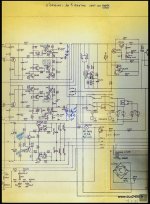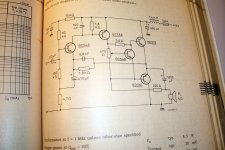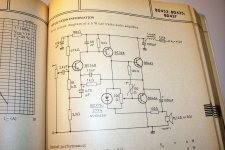On that, i agree 100%. And it is a religion. (joke again)One thing has to be remembered at all times: without at least a semblance of metric, no progress is possible (except in religion, of course but it is exempted). Audio is no exception to that rule.
I had made the effort to provide two sims of the same amp, VFB vs CFB. You can't deny my effort on that. Sims are not a kind of metric ?
For the other part of your answer, there is a funny thread, in this forum about sound of cables. I can listen differences of sound with different loudspeakers cable's capacitance on long distances, (special when they make the amp oscillate), with non linear Z loudspeakers and diameters, no more. And my answer about cables is this citation: "I tend to prefer those witch conduct electricity". Read my signature, to know my position.
Last edited:
Please pay attention Elvee :There is no OLG shown there ,is only gain for the first stage .That's what I said, a mistake: measuring the OLG of a circuit block with a third terminal injecting something into the said block is wrong
.
The measurement shows the gain and phase of the Ltp ..
By the way, and despite i had never pretended to have invented anything else than the patents i have deposed, look at this schematic of the Mach50 we designed in 1970 and a link to the site of a guy witch had make a restoration of it. (Please, look at the feedback !)then some guy arrives, picks and chooses a bit or another of various theories to their own convenience and claims he has discovered something
SCIENTELEC Haute Fidélité française
and the measurements he made (remember 1970 !)
RightMark Audio Analyzer test : Mach_A50S
The" audiophile" word was not even invented. And, sorry, but, yes we used to listen to our work (not the way you describe, but with criticism) as much as we where making measurements at each step, because there is no other way to work for audio in a research and development office.
We where the first, i believe to provide a 24pos rotator with constant impedance to replace potentiometers and a physiological circuit, following exactly the Fletcher and Mudson curves.
Attachments
Last edited:
with proper metrics to decide which one is better, and proper methodology to remove statistical noise from the results..
If there is ever such metrics.
With blind test, I will set up a system that will display the strengths of the CFB. And blind test, especially by experts, tho not scientific, is the best way to decide which one is best. Because there is no scientific approach, even if you want to pretend that there is one.
I trust my honesty. If I found the VFB sound better I will right away throw away my CFB. I have no special relationship with CFB anyway. And if everyone is as honest, no need a blind test. Just show two amps and we will build both of them and give our reports.
Jay,
I disagree that HEXFETS in class AB will never sound good enough. For my TV setup I use Pioneer A107amp with Tannoy Mercury M1 loudspeakers. Pioneer uses IRF 530/9530 in output in class AB and the sound is superbly fast, fluid and musical.
"Good enough" is relative. Your Pioneer (and speaker) is for "kids". It is not even at average level. It uses an opamp that if I'm not mistaken around 6v/us slew rate. Very bad. Go to SSA thread if you want a simpler, yet better amp.
ADD: The Stochino is the best amp I have built with hexfet at class-B.
Can-you develop a little, Jay ?
It's just like the basic of latfet-SSA as built by Nico and Shaan, but the latfet is replaced with HEXFET plus a (5401/5551) driver. I was trying to help others with "cheap" SSA/CFB (using cheap hexfet, and no need big heatsink and transformer), but the result was not good. Hexfets are for class-A I guess.
Last edited:
look at this schematic of the Mach50 we designed in 1970 and a link to the site of a guy witch had make a restoration of it. (Please, look at the feedback !)
SCIENTELEC Haute Fidélité française
The vast majority of the amplifiers from that era (~'65 to '75) had a single supply and capacitive coupling.
That configuration of the single transistor used as a subtractor was therefore the most straightforward, economical and effective, and it was used in ~75% of amplifiers designed at that time.
First, three examples using Ge transistors, from Philips, Siemens and Thomson.
Then, some later examples based on silicon.
But there was no awareness or intent from the designers to create CFB, quite the opposite in fact: this effect was seen as nuisance, as it spent uselessly part of the loop gain.
There were therefore "clever" attempts to circumvent the effect, without using a disproportionately large feedback electrolytic (necessitated by the low impedance of the FB network).
The next pic shows an example of such a smart scheme, where the speaker is part of the impedance of the FB divider.
Finally, a curiosity: an amplifier duplicating the tube OTL, with a composite MOS/bjt IC as input, also with CFB.
Now, you could say that CFB already existed at the time, but unbeknown of the designers, "à l'insu de leur plein gré", just like Mr Jourdain had been speaking prose all his life without knowing it.
Attachments
-
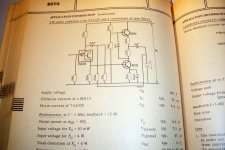 100_5338.JPG286.3 KB · Views: 140
100_5338.JPG286.3 KB · Views: 140 -
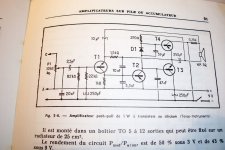 100_5354.JPG251.7 KB · Views: 142
100_5354.JPG251.7 KB · Views: 142 -
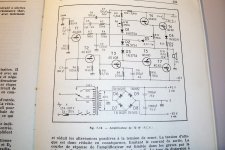 100_5349.JPG286.7 KB · Views: 125
100_5349.JPG286.7 KB · Views: 125 -
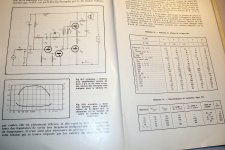 100_5357.JPG314.4 KB · Views: 112
100_5357.JPG314.4 KB · Views: 112 -
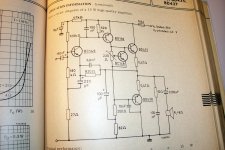 100_5347.JPG297.4 KB · Views: 125
100_5347.JPG297.4 KB · Views: 125 -
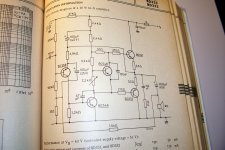 100_5343.JPG300.1 KB · Views: 130
100_5343.JPG300.1 KB · Views: 130 -
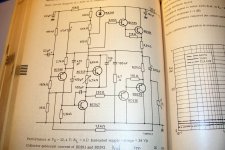 100_5339.JPG311.3 KB · Views: 218
100_5339.JPG311.3 KB · Views: 218 -
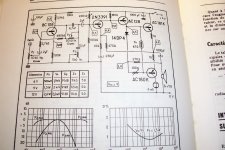 100_5352.JPG300.2 KB · Views: 223
100_5352.JPG300.2 KB · Views: 223 -
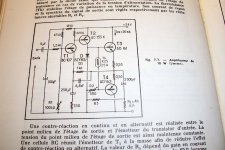 100_5356.JPG289.4 KB · Views: 232
100_5356.JPG289.4 KB · Views: 232 -
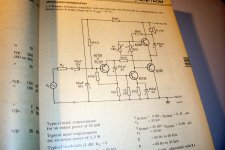 100_5336.JPG293.9 KB · Views: 235
100_5336.JPG293.9 KB · Views: 235
Jay,
I never claimed that Pioneer/Tannoy pair is state of the art. Like I said it is for low power reproduction from TV/FM tuner, it is not my main music reproduction system. Although budget priced, Pioneer amp is excellent sounding and the circuit is very good. It is not run of the mill Japanese product but the work of some clever and very competent Japanese engineer. I know Stochino circuit and I do not think that building it would bring any real improvement in sound quality over Pioneer circuit.
I do not think that Japanese engineers are less competent than any other engineers just because they remain nameless and because they work for big companies. In fact, just the opposite may be the case.
I never claimed that Pioneer/Tannoy pair is state of the art. Like I said it is for low power reproduction from TV/FM tuner, it is not my main music reproduction system. Although budget priced, Pioneer amp is excellent sounding and the circuit is very good. It is not run of the mill Japanese product but the work of some clever and very competent Japanese engineer. I know Stochino circuit and I do not think that building it would bring any real improvement in sound quality over Pioneer circuit.
I do not think that Japanese engineers are less competent than any other engineers just because they remain nameless and because they work for big companies. In fact, just the opposite may be the case.
It was a common practice in tube amps, long time before Germanium, yes.Now, you could say that CFB already existed at the time, but unbeknown of the designers, "à l'insu de leur plein gré", just like Mr Jourdain had been speaking prose all his life without knowing it.
I'm impressed with your schematic library ! We had no time, on our side, to look at other's company work. some in the datasheets, yes...
Note: Our amp had something a little special at this time, using the first planar power transistors for more speed (BDY56, if i remember well)...
Now, you could say that CFB already existed at the time, but unbeknown of the designers, "à l'insu de leur plein gré", just like Mr Jourdain had been speaking prose all his life without knowing it.
Quite some memories...😉
I have the french book wich you are displaying schematics from.
Just remember the whole bunch of theses early unwillingly CFB designed amps ,
and the remaining impression after all this time is that , although
a majority did more or less work , they were also as a majority
of poor quality..😀
The generalisation of the LIN was a relief and we could then talk
of hifi amplifiers and get rid of thoses designs where you could
often improve a parameter only by degrading another one....
So true.they were also as a majority of poor quality...
First transistors amps had a justified bad reputation. At this time, no one i knew was able to compete with my tube Macintosh.
The company i worked for at this time had started his history, before our arrival, selling kits and amps, based on an RCA schematic, with 2N3055s. Cheap and absolutely awful !
We had worked a lot on this Mac 50 to make-it a good 2X50W amp.
And i suppose we reached our goal, because it was my preferred amp during decades (despite grass is always greener elsewhere) and the guy witch had refurbished-it has published positive comments on its sound.
"When released in 1971, this unit which remained until the end the flagship of the manufacturer, was a racing car in front of witch very few American or Japanese amplifiers could compete.
Amazing performance (0.05% THD) instantaneous power 200W, volume controls and tone controls with switched fixed resistors, protection against overload, such were the characteristics of this amazing amp. This copy is one that my dad bought in 1973"
and, in a mail to me:
"These amplifiers are still along the best I have ever been given to listen."
I was pretty proud of it 🙂
I think modern CFB amps are a world away from the designs shown by ELvee above. And the topology is now underpinned by some serious math, which I don't think was the case back then. You may recall that CFB really took off in the mid 1980's when a slew of CFB op amps were released by the major semi companies. I still have somewhere copies of articles on CFB from EDN and the like.
But, I think all this discussion about CFB vs VFB will not lead to a clear conclusion. I have heard, and now built both topologies and it's quite possible to design good sounding amps of either type - different, but both sound great.
But, I think all this discussion about CFB vs VFB will not lead to a clear conclusion. I have heard, and now built both topologies and it's quite possible to design good sounding amps of either type - different, but both sound great.
Jay,
I never claimed that Pioneer/Tannoy pair is state of the art. Like I said it is for low power reproduction from TV/FM tuner, it is not my main music reproduction system. Although budget priced, Pioneer amp is excellent sounding and the circuit is very good. It is not run of the mill Japanese product but the work of some clever and very competent Japanese engineer.
I was trying to point out that "good enough" is a relative thing. A young boy may come to this site telling that he has built a GREAT sounding one-transistor amp. "Great" here doesn't mean anything, because it is relative, probably relative to this young boy pocket radio.
Same with your statement that hexfet can make a "good" amp...
But my statement was: "I will and have assumed that IRF in class-B will never sound good enough". That because I have built many amps and that is my current statistics. Theoretically they have too high input capacitance.
"Good enough" also relative to other high quality amps that I have been trying to search and build. So if you think the A207 is good, that's a valid statement. But...
I know Stochino circuit and I do not think that building it would bring any real improvement in sound quality over Pioneer circuit.
What do you mean you "know" Stochino circuit? It is to me much much better than the pioneer. Like heaven and earth. Soundwise, and also in simulation (actually, Stochino amplifier simulated performance is very unique, rarely seen).
I'am quite confident that both types of feedback can yield superior results... what could be interesting also to discuss is what kind of demands the two types put on the rest of the circuit.
I was trying to point out that "good enough" is a relative thing. A young boy may come to this site telling that he has built a GREAT sounding one-transistor amp. "Great" here doesn't mean anything, because it is relative, probably relative to this young boy pocket radio.
Same with your statement that hexfet can make a "good" amp...
But my statement was: "I will and have assumed that IRF in class-B will never sound good enough". That because I have built many amps and that is my current statistics. Theoretically they have too high input capacitance.
"Good enough" also relative to other high quality amps that I have been trying to search and build. So if you think the A207 is good, that's a valid statement. But...
What do you mean you "know" Stochino circuit? It is to me much much better than the pioneer. Like heaven and earth. Soundwise, and also in simulation (actually, Stochino amplifier simulated performance is very unique, rarely seen).
I mean I have seen Stochino schematics: fully symetrical circuit, very high slew rate, etc. But complicated for diy unless one has original pcb-s. I must admit that it would be very difficult to make single pcb just to try a circuit. Stochino is probably very good but I do not have pcb to prove it.
Bonsai/MiiB, I share your sentiment completely, neither CFB or VFB is better than the other. If both are designed with the same care and objective, they may sound very different or even very similar. for as many reasons/arguments as we can think of and put forward.
If there really did exist a BEST sounding design, then why do we not all own one.
If there really did exist a BEST sounding design, then why do we not all own one.
Last edited:
Bonsai/MiiB, I share your sentiment completely, neither CFB or VFB is better than the other. If both are designed with the same care and objective, they may sound very different or even very similar. for as many reasons/arguments as we can think of and put forward.
If there really did exist a BEST sounding design, then why do we not all own one.
Agree!
Most studio and sound reinforcement power amps these days use complex fully symetrical circuits (a la famous Bongiorno) with great number of transistors. No doubt, these amps have excellent specs and sound very good, but simple CF design, such as Esperado did in 1971, still sound better, and that is what really counts. Sure, there is more of DC offset, but it could be tamed to safe levels.
Most studio and sound reinforcement power amps these days use complex fully symetrical circuits (a la famous Bongiorno) with great number of transistors. No doubt, these amps have excellent specs and sound very good, but simple CF design, such as Esperado did in 1971, still sound better, and that is what really counts. Sure, there is more of DC offset, but it could be tamed to safe levels.
I don't think so.
The number of transistors in a circuit has nothing to do with sound. Take a look at an Accuphase for example. Many active devices in the signal
Then some may think that Accuphase is not really what makes you thick...
I'am 100% in favour of simple designs, or at least designs with a short and low component count in the signal-path...
I don't aim for low(ish) feed back, but I Do aim for feedback that add's in a dynamically linear way... hence my quest for the demands on the rest of the circuit. For current feedback CCS drive is in my book mandatory.
I'am 100% in favour of simple designs, or at least designs with a short and low component count in the signal-path...
I don't aim for low(ish) feed back, but I Do aim for feedback that add's in a dynamically linear way... hence my quest for the demands on the rest of the circuit. For current feedback CCS drive is in my book mandatory.
- Status
- Not open for further replies.
- Home
- Amplifiers
- Solid State
- Is the CFB topology superior, and why?
